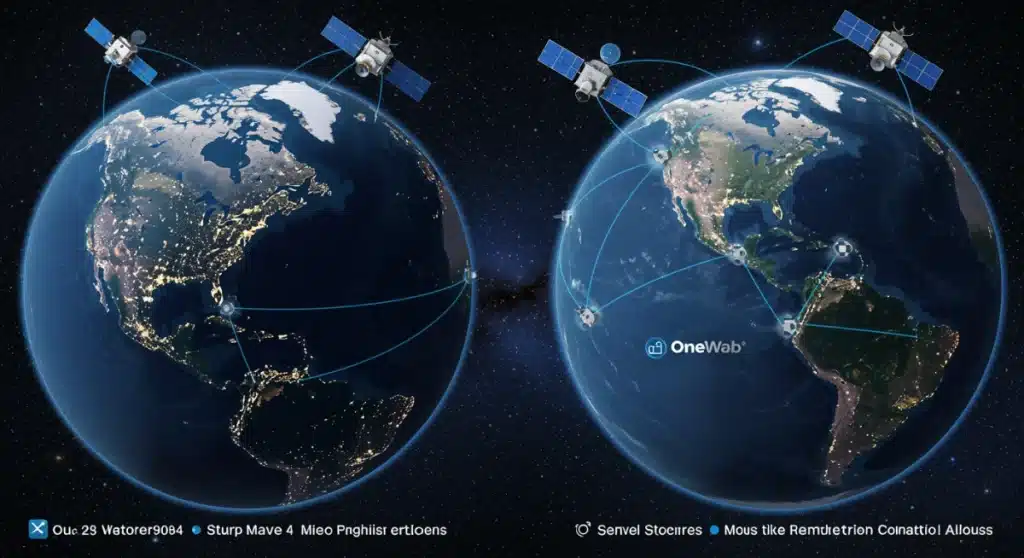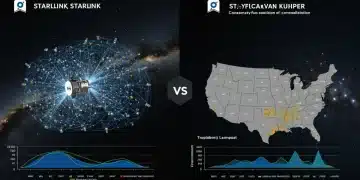Starlink vs. OneWeb: Remote US Connectivity 2025 Analysis

The Starlink OneWeb Comparison for global connectivity in remote US regions for 2025 reveals distinct technological approaches and market strategies aimed at bridging the digital divide, with each system presenting unique advantages and challenges for consumers.
As 2025 approaches, the race to provide reliable global connectivity, especially in remote US regions, intensifies. A critical Starlink OneWeb Comparison emerges as these two satellite internet giants vie for market dominance, promising to transform how underserved communities access the digital world. This analysis focuses on their current standing, technological differences, and what this means for American users seeking high-speed internet where traditional options fall short.
Understanding the core technologies: Starlink’s LEO constellation
Starlink, operated by SpaceX, employs a vast constellation of satellites in low Earth orbit (LEO), typically at altitudes of 340 to 550 kilometers. This proximity to Earth is a cornerstone of its design, aimed at dramatically reducing latency, a critical factor for internet performance, especially for real-time applications like video conferencing and online gaming. The system relies on small, user-friendly dish antennas that automatically align with passing satellites, making installation relatively straightforward for end-users.
The sheer number of Starlink satellites, projected to grow into tens of thousands, allows for continuous coverage and high bandwidth capacity. This dense network is crucial for serving geographically dispersed populations in remote US areas, where traditional fiber or cable infrastructure is cost-prohibitive to deploy. Starlink’s iterative deployment strategy means new satellites are launched frequently, continuously expanding and enhancing the network’s capabilities, constantly refining its service offerings and reach.
Starlink’s technical advantages for remote users
- Low Latency: Satellites in LEO minimize signal travel time, providing a more responsive internet experience.
- High Speeds: With a growing number of satellites, Starlink aims to deliver speeds comparable to terrestrial broadband.
- Ease of Installation: User terminals are designed for simple self-installation, reducing the need for professional technicians in remote areas.
Starlink’s approach emphasizes a direct-to-consumer model, providing a full-service solution from satellite to user terminal. This integrated strategy gives SpaceX significant control over the entire user experience, allowing for rapid deployment of new features and service improvements. The company’s continuous innovation in satellite design and launch capabilities further solidifies its position as a leading contender in the remote connectivity landscape for 2025.
OneWeb’s LEO network: A different approach to global coverage
OneWeb, in contrast, also utilizes a LEO satellite constellation but with a different architectural philosophy. Its satellites operate at a slightly higher altitude, around 1,200 kilometers, and are fewer in number compared to Starlink, though still substantial. OneWeb’s strategy focuses more on a wholesale model, partnering with telecommunications providers and governments to deliver backhaul services and connectivity solutions, rather than directly serving individual consumers.
This partnership-driven model means OneWeb’s services often integrate into existing infrastructure, providing robust internet access to communities, businesses, and critical services in remote US locations. Their focus on enterprise and government clients implies a strong emphasis on reliability, security, and dedicated bandwidth, crucial for applications that demand consistent performance. The company has steadily expanded its coverage, particularly in northern latitudes, a key region for remote US communities.
OneWeb’s strategic differentiators for remote connectivity
- Wholesale Model: Partnerships with local ISPs and governments can leverage existing infrastructure and expertise.
- Enterprise Focus: Tailored solutions for businesses, schools, and government agencies seeking reliable high-speed connections.
- Global Coverage: Aiming for comprehensive global coverage, including challenging Arctic regions, vital for remote US outposts.
OneWeb’s collaboration with established players in the telecommunications sector can accelerate deployment and adoption in remote areas that might otherwise face significant hurdles. This indirect approach can also offer more integrated solutions for larger organizations or community-wide projects, making it a compelling option for certain segments of the remote US market in 2025. The Starlink OneWeb Comparison highlights these differing market strategies as a key distinction.
Performance metrics: Speed, latency, and reliability in 2025
When evaluating satellite internet for remote US regions in 2025, speed, latency, and reliability are paramount. Starlink generally promises higher peak speeds, often advertised in the range of 50-200 Mbps, with some users reporting even faster downloads. Its lower LEO altitude contributes to very low latency, typically between 20-40 ms, making it suitable for latency-sensitive applications. However, performance can vary based on network congestion, obstructions, and the number of active users in a given cell.
OneWeb, while also providing high-speed broadband, tends to focus on consistent, guaranteed bandwidth for its enterprise clients, often offering speeds in the range of 50-100 Mbps. Its slightly higher orbit might result in marginally higher latency compared to Starlink, but still significantly lower than traditional geostationary satellite internet, typically around 70-100 ms. For many business and community applications, this level of performance is more than adequate and highly reliable due to dedicated service agreements.

Key performance indicators for remote users
- Starlink Speeds: Higher peak speeds, variable based on network load and user density.
- OneWeb Speeds: Consistent, guaranteed speeds, often tailored for enterprise needs.
- Latency: Both offer significantly lower latency than traditional satellite, with Starlink often having a slight edge.
Reliability is another critical factor. Both systems are designed for high uptime, but environmental factors like heavy weather can temporarily impact satellite signals. Starlink’s larger constellation offers more redundancy, potentially mitigating outages from individual satellite failures. OneWeb’s robust ground infrastructure and partnerships also contribute to a resilient network, ensuring dependable service for its target clientele. The Starlink OneWeb Comparison in terms of raw performance often comes down to the specific needs of the user or organization.
Cost structures and accessibility for remote US regions
The financial aspect of satellite internet is a major consideration for remote US users. Starlink operates with a direct-to-consumer pricing model, which typically involves a significant upfront cost for the hardware (dish, router, mounting equipment) and a recurring monthly subscription fee. While these costs have fluctuated, they reflect the advanced technology and extensive network infrastructure required to deliver service.
OneWeb’s cost structure is less transparent for individual consumers due to its wholesale model. The final cost to end-users in remote US regions would depend on the pricing strategies of its partner ISPs or the terms of government contracts. Generally, enterprise-grade services tend to have higher costs but also come with service level agreements (SLAs) and dedicated support, which can be invaluable for critical operations. For a thorough Starlink OneWeb Comparison, potential users must consider their budget and specific service requirements.
Financial considerations for remote internet access
- Starlink Hardware Cost: Significant upfront investment for user equipment.
- Starlink Subscription: Monthly fees that can be higher than traditional broadband, but offer superior performance in remote areas.
- OneWeb Pricing: Varies based on partner agreements; typically higher for enterprise solutions but with added benefits.
Accessibility also encompasses geographical coverage and regulatory approvals. Both companies are continuously expanding their service areas across the US. Starlink has a broader footprint for individual consumers, while OneWeb’s enterprise focus means its services might be deployed in specific community hubs or industrial sites first. Government subsidies and programs aimed at bridging the digital divide in remote areas could also play a significant role in making either service more accessible and affordable for residents in 2025.
User experience and customer support
The user experience with Starlink typically begins with self-installation of the ‘Dishy’ terminal, guided by a mobile app. The app also provides real-time performance data and troubleshooting tips. Customer support is primarily handled through an online ticketing system, which can sometimes lead to longer response times, a point of concern for some users, especially in critical situations. However, the system is designed to be largely self-sufficient, minimizing the need for frequent support interactions.
OneWeb, given its wholesale model, places the immediate customer support responsibility on its partner ISPs or integrators. This can be an advantage, as users might receive more localized and personalized support from providers familiar with their specific needs and regional context. For enterprise clients, dedicated account managers and technical support teams are often part of the service package, ensuring high-priority assistance. This difference in support models is a key aspect of the Starlink OneWeb Comparison for service delivery.

Evaluating the customer journey
- Starlink Installation: User-friendly DIY setup.
- Starlink Support: Primarily online, self-service oriented.
- OneWeb Installation: Professional installation via partners.
- OneWeb Support: Via partner ISPs, potentially more localized and personalized.
The reliability of the equipment and the network itself also contributes to user experience. Both companies invest heavily in robust hardware and resilient satellite networks. However, the experience can vary depending on factors like local weather conditions, line of sight to satellites, and the specific service plan chosen. As 2025 progresses, both providers are expected to refine their service delivery and support mechanisms to better cater to the unique demands of remote US users.
Future outlook and market implications for 2025
Looking ahead to 2025, both Starlink and OneWeb are poised for significant expansion and evolution. Starlink continues to launch satellites at an aggressive pace, aiming to increase capacity, reduce latency further, and expand coverage to even more remote and challenging US geographies. Its direct-to-consumer model allows for rapid iteration and responsiveness to market demands, potentially introducing new service tiers or hardware innovations.
OneWeb, now under the ownership of a consortium including the UK government and Bharti Global, is also focused on completing its constellation and expanding its partnerships. Its emphasis on enterprise, government, and maritime sectors positions it as a critical infrastructure provider, potentially complementing Starlink’s consumer-focused approach. The Starlink OneWeb Comparison in 2025 will likely see both companies carving out distinct niches while collectively contributing to closing the digital divide.
Anticipated developments in remote connectivity
- Increased Capacity: Both networks will likely expand to handle more users and higher data demands.
- Technological Advancements: Continuous innovation in satellite design, ground stations, and user terminals.
- Policy and Subsidies: Government initiatives will continue to shape the affordability and accessibility of these services.
The competitive landscape will also be influenced by emerging players and evolving regulatory frameworks. The demand for reliable, high-speed internet in remote US regions is immense, and both Starlink and OneWeb are critical players in meeting this need. Their ongoing development will not only transform connectivity but also foster economic growth and improve quality of life in areas traditionally left behind by broadband expansion.
Key Aspect |
Description |
|---|---|
Target Audience |
Starlink: Consumers; OneWeb: Enterprise/Government via partners. |
Network Model |
Starlink: Direct-to-user; OneWeb: Wholesale to ISPs. |
Latency |
Starlink: Lower (20-40ms); OneWeb: Slightly higher (70-100ms). |
Cost Structure |
Starlink: Upfront hardware + monthly; OneWeb: Via partner pricing. |
Frequently asked questions about satellite internet in remote US
Starlink primarily offers direct-to-consumer services with user-installed dishes, focusing on individual users. OneWeb, conversely, operates on a wholesale basis, partnering with telecommunications providers and governments to deliver connectivity solutions to larger entities and communities.
Starlink generally offers lower latency, typically between 20-40 milliseconds, due to its satellites operating at lower Earth orbits (LEO). OneWeb’s satellites are slightly higher, resulting in latencies usually ranging from 70-100 milliseconds, still a significant improvement over traditional GEO satellites.
Starlink has a clear upfront hardware cost and a monthly subscription fee directly to consumers. OneWeb’s costs are determined by its partner providers, often bundled into enterprise or community-wide packages, making direct individual comparison difficult but typically higher for dedicated services.
Both Starlink and OneWeb are making significant strides in providing high-speed internet to underserved areas. By 2025, their expanded coverage and improved performance are expected to substantially reduce the digital divide, offering viable alternatives where traditional infrastructure is lacking.
Government subsidies and programs are crucial for making satellite internet more affordable and accessible in remote US regions. These initiatives can help offset hardware costs or monthly fees for consumers and support community-wide deployments through OneWeb’s partnerships.
Outlook for remote US connectivity
The ongoing Starlink OneWeb Comparison underscores a pivotal moment for global connectivity in remote US regions. As 2025 unfolds, the advancements from both providers will increasingly shape the digital landscape for millions. Key developments to monitor include further satellite launches, the introduction of new service tiers, and the impact of evolving government policies designed to expand broadband access. The competition between these two giants promises continued innovation and improved service, ultimately benefiting underserved communities seeking reliable, high-speed internet.





